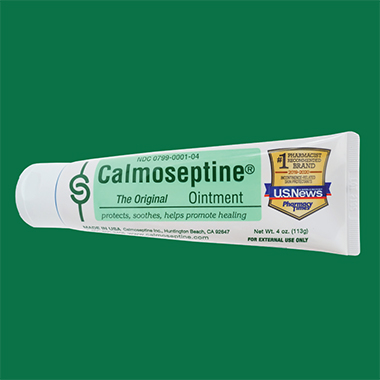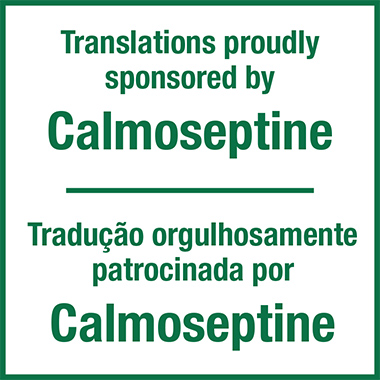Volume 41 Number 4
Hand dermatitis among nurses during the COVID-19 pandemic: frequency and factors
Ayla İrem Aydın, Meryem Atak, Nurcan Özyazıcıoğlu Nurcan and Vahit Dalkızan
Keywords nursing, Wound care, handwashing, COVID-19, dermatitis, hygiene
For referencing Aydın Aİ et al. Hand dermatitis among nurses during the COVID-19 pandemic: frequency and factors. WCET® Journal 2021;41(4):10-14
DOI
https://doi.org/10.33235/wcet.41.4.10-14
Submitted 7 December 2020
Accepted 10 February 2021
Abstract
Objective To determine the frequency of hand dermatitis among nurses during the COVID-19 pandemic and factors affecting its prevalence.
Methods The research sample consisted of 175 nurses working in state hospitals. Research data were collected via Google Survey between October and September 2020. The data were collected using a Sociodemographic Data Collection Form, and a self-assessment form was used to determine dermatologic symptoms.
Results The frequency of hand dermatitis among nurses was 70.9%. A statistically significant difference was found between sex, allergy history, and increased frequency of handwashing and the frequency of hand dermatitis. No significant difference in terms of the frequency of hand dermatitis was found between the nurses who provided care to patients who were COVID-19 positive versus the nurses who did not provide care to patients who were COVID-19 negative. However, the frequency of washing hands and using hand disinfectants and hand creams was found to have increased significantly during the COVID-19 pandemic compared to the prepandemic period.
Conclusions The frequency of hand dermatitis increased among nurses during the pandemic. The increased frequency of handwashing during the pandemic poses a risk for hand dermatitis among nurses, although this should not discourage nurses from appropriate hygiene.
Introduction
The World Health Organisation has declared COVID-19 a global pandemic. According to the latest data, approximately 230 million people have been infected and 4.7 million have died.1 Nonpharmacologic preventive practices such as maintaining social distance, wearing face masks, and washing hands have been recommended to hinder the spread of the virus.2 These practices play an important role in reducing the risk of transmission by preventing the spread of aerosols and protecting vulnerable populations. Studies suggest that hand hygiene is an important prevention strategy for healthcare professionals and societies in places where the pandemic is most prevalent. Hand hygiene remains a critical element of infection control.3-5
The COVID-19 pandemic has also had the effect of reminding nurses about the need for regular hand hygiene with soap, water, or alcohol-based sanitisers. Handwashing is recommended as an inexpensive and common preventive measure to protect oneself from a number of viral infections and prevent disease spread in general.6
Proper handwashing technique is a part of effective hand hygiene.5 The CDC recommends handwashing with soap because it reduces the amount of germs and chemicals on the hands.2 The World Health Organisation (WHO) also recommends handwashing with soap for 40 to 60 seconds using an appropriate technique when hands are noticeably dirty.7 When soap and water are not available, a hand sanitiser with at least 60% alcohol can be used.2 If hands are not visibly soiled, using an alcohol-based hand disinfectant for 20 to 30 seconds with the appropriate technique is preferred to provide hand hygiene.7 Washing hands with an alcohol solution can reduce the risk of infection in medical staff and others in the community by reducing the number of bacteria and viruses on hands.2,8
However, the solutions used, frequency of handwashing, level of moisture, and hand drying process may disrupt the skin barrier and lead to symptoms of hand dermatitis.9-12 Accordingly, the aim of this study was to determine the frequency of hand dermatitis among nurses during the COVID-19 pandemic and the factors affecting its incidence.
Methods
Sample
The research population consisted of nurses working in three different state hospitals in Bursa, Turkey. The research sample consisted of 175 nurses who voluntarily agreed to participate in the study.
Data Collection
The study data were collected by the researchers between September and October 2020 via Google Survey. Data collection tools included two forms prepared by the researchers: one form collected sociodemographic information and the other assessed dermatologic symptoms.
Sociodemographic Data Collection Form. This form consisted of questions about the sex, age, and education level of the nurses who participated in the study, as well as about the hospital and clinic they worked in, and their total years of employment.
Form to Determine Dermatologic Symptoms. This form included questions about allergy history, medication use, the COVID-19 status of the nurse’s patients, frequency of handwashing, and use of hand disinfectants and hand creams. In the last part of the form, nurses were asked to self-assess any dermatologic symptoms specific to hand dermatitis. The form was translated into Turkish by a researcher and a native English speaker. The translations were compared, the most appropriate terminology was selected, and the final version was then translated back into English. The translated text was compared with the original form and revised accordingly. The authors of the study have previously used this self-assessment form with pediatric nurses and nursing students.11,12 The form co-evaluates the symptoms of irritant and allergic contact dermatitis and was designed according to the criteria of Smit et al.13,14 Permission was obtained from Coenraads et al for the use of this form.13,14
Questions were posed about the presence of any of the following symptoms over the last 12 months:
- Scaling and redness on the hands and between the fingers
- Fissures and redness on the hands
- Irritation or itching on hands
- Swelling and redness of the hands
- Vesicles between hands and fingers
Participants who answered “Yes” to one or more of these questions were diagnosed with symptoms of hand dermatitis.
The following questions were also asked:
- Did two or more of these symptoms last longer than 3 weeks?
- Did two or more of these symptoms occur more than once?
Participants who answered “Yes” to either of these questions were diagnosed with recurrent or severe hand dermatitis. The Cronbach α coefficient of the form was 0.888.
Data Analysis
Numeric and percentile distributions were used for sociodemographic data and Mann Whitney U test, Wilcoxon Sign rank test, and Pearson χ2 test were used for comparisons. The SPSS for Windows Version 23.0 of was used for data analysis.
Ethical Considerations
Ethical approval for the research was received from Bursa Uludağ University Health Sciences Research and Publication Ethics Committee (date and decision number: 29.07.2020; 92662996-04). Legal permission was obtained from the relevant health institutions. Consent was obtained from the nurses who participated in the study via the Google Survey.
Results
Table 1 shows the personal characteristics of the nurses participating in the study. The frequency of hand dermatitis among the nurses was 70.9% (124 of 175). The frequency of hand dermatitis was significantly higher in women than in men. The frequency of hand dermatitis was significantly higher among nurses who had a history of allergies compared with those without an allergy (P < .05). The mean age of the nurses participating in the study was 29.14 ± 7.22, and the mean years of employment were 6.68 ± 8.02. No significant difference was found in the frequency of hand dermatitis among nurses by mean age or years of employment. When the incidence of hand dermatitis was examined by unit where the nurses worked, the frequency was higher among nurses working in pediatric (76.1%), surgical (76%), and COVID-19 wards (69.5%). However, no significant difference was found by unit (P > .05).
Table 1. Participant characteristics
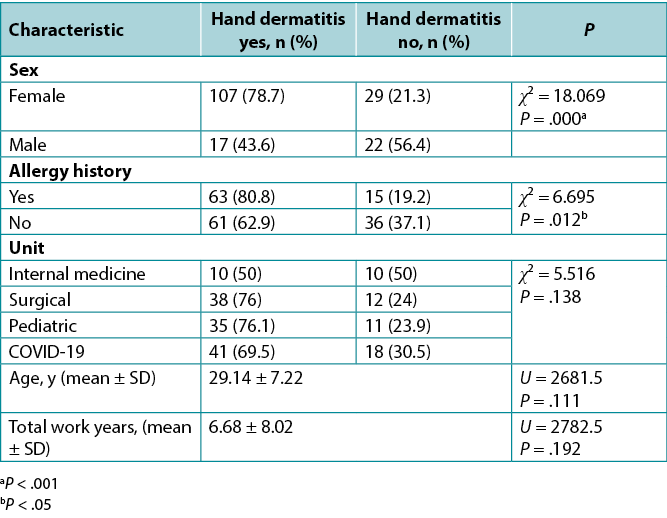
The most frequently reported symptoms were redness and fissures (sharply defined linear tears in the epidermis and dermis; 77.1%), irritation and itching (76%), and scaling/rash (67.4%; Figure 1).
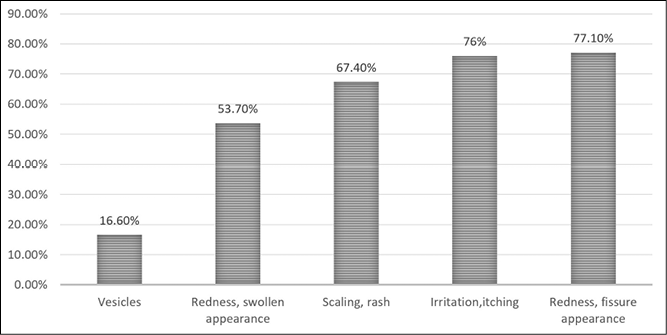
Figure 1. hand dermatitis symptoms
The frequency of hand dermatitis was 71.5% among nurses who provided care to patients who were COVID-19 positive, whereas the frequency of hand dermatitis was 66.7% among nurses who did not provide care to COVID-19 positive patients. This difference was not significant (Table 2).
Table 2. Frequency of hand dermatitis based on whether nurses cared for patients positive for COVID-19
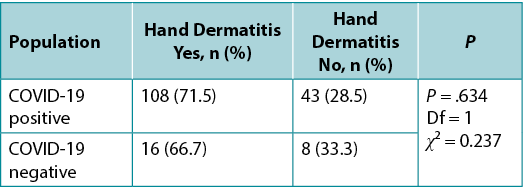
Nurses’ hand hygiene behaviours before and during the COVID-19 pandemic were examined (Table 3). It was determined that the frequency of handwashing per day, the use of disinfectants, and the use of hand cream/moisturiser had increased significantly during the pandemic (P < .001). In terms of handwashing frequency, 48% (84 of 175) of the nurses washed their hands more than 25 times a day. The frequency of hand dermatitis significantly increased with the frequency of handwashing (Table 4; P < .05). The frequency of hand disinfectant and hand cream use did not significantly affect hand dermatitis (P > .05). The most frequently used handwashing substances were liquid soap, liquid soap and alcohol-based gel, chlorhexidine-based gel, and alcohol-based gel (Figure 2).
Table 3. Hand hygiene behaviors of nurses before and during the pandemic

Table 4. Frequency of hand dermatitis by hygiene behavior
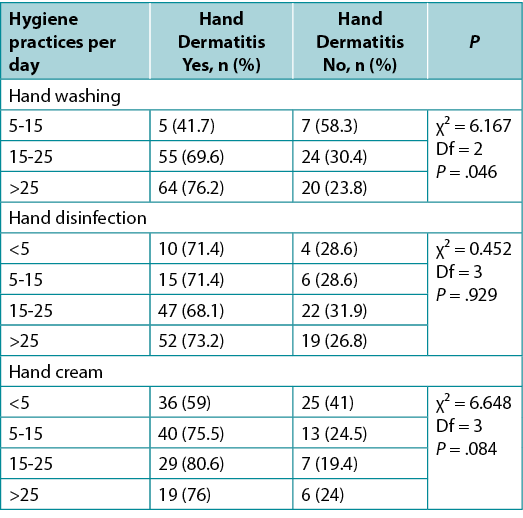
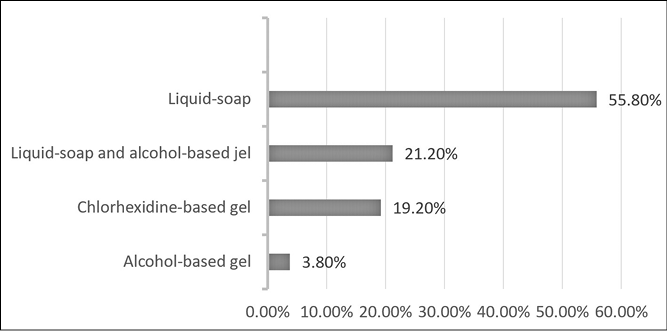
Figure 2. substances used by nurses for handwashing
Discussion
Hand dermatitis is a common disease that can progress either acutely or chronically and has different etiologies.15 In the current study, the frequency of hand dermatitis among nurses during the COVID-19 pandemic was 70.9%. The results of the current study were similar to those obtained in other studies conducted on hand dermatitis in health workers during the COVID-19 pandemic. One study conducted during the pandemic revealed that 84.6% of health workers had unwanted skin reactions on their hands.16 Another study reported that 74.5% of primary health workers had skin damage on their hands.10 A study conducted at the beginning of the pandemic found that 90.4% of health workers had acute symptoms of hand dermatitis.17
In a study conducted before the pandemic in the same region as the current study, 47.5% of the nurses working in pediatric clinics were reported to have hand dermatitis.11 The frequency of hand dermatitis was found to be 12%,18 21%,19,20 and 22.1%21 in other studies conducted before the pandemic. Given these results, it is clear that the frequency of hand dermatitis had increased among health workers during the pandemic.
In this study, the frequency of hand dermatitis was significantly higher in women than in men. Alluhayyan et al22 conducted a study with health workers and found that women were more prone to dermatitis. Likewise, Gupta et al23 found that hand dermatitis was slightly more common in women than in men. However, other studies have reported that sex did not have a significant effect on the frequency of hand dermatitis.12,21
Allergies are abnormal hypersensitivity reactions of the immune system against foreign substances.24,25 This response can be observed in early childhood as well as in adolescence and adulthood.25,26 The frequency of hand dermatitis was significantly higher among nurses who had a history of allergy compared with those without an allergy, which is consistent with previous studies.12,19,21,23 However, Kiely et al27 concluded that a history of allergy did not affect the development of dermatitis, despite reporting that the risk of developing dermatitis was significantly higher in health workers with a history of dermatitis.
One of the most common methods to prevent the spread of viruses is effective hand hygiene. In the fight against COVID-19 it is essential that effective hand hygiene habits are acquired in childhood.28 Kiely et al27 reported that the frequency of handwashing increased among almost all health workers (99.26%) during the pandemic. When the prepandemic and pandemic periods were compared in the current study, the frequency of handwashing and use of hand disinfectants/creams had increased significantly (Table 3). Similarly, Guertler et al17 conducted a study with physicians and nurses and found similar results. All of the guidelines for combating COVID-19 recommend thorough and frequent hand hygiene practices.2,5 Although the increase in the frequency of handwashing is one of the factors that contributes to the development of dermatitis, this should not dissuade health workers from appropriate hand hygiene practices during the pandemic.4
Nurses are the primary caregivers in a medical setting and are thus prone to infection with and transmission of the COVID-19 virus. It is vital that they comply with the guidelines for preventing and controlling infections to fight the pandemic.29
In another study conducted during the pandemic, Lan et al10 concluded that the frequency of hand dermatitis increased significantly in health workers who washed their hands more than 10 times a day. Studies conducted before the pandemic reported a significant relationship between an increased frequency of handwashing and the frequency of hand dermatitis.12,30 However, the present study found no significant difference in the frequency of hand dermatitis by use of hand cream. However, the hand creams used by nurses may not be ideal. The use of skin moisturisers is recommended to maintain healthy skin;31,32 for skin protection, humectants such as topical urea and propylene glycol and occlusive emollients such as petrolatum-based products, lanolin, mineral and vegetable oils, and waxes together are recommended. Concomitant use is beneficial to keep the stratum corneum moist and soothe the skin.33
Conclusions
This study found that the frequency of hand dermatitis among nurses during the pandemic was high. Sex, history of allergy, and increased frequency of handwashing were among the factors increasing hand dermatitis. Hand hygiene increased significantly among health workers during the pandemic. It was also found that nurses increased the measures they took to protect their skin to avoid dermatitis.
Hand disinfection plays an important strategic role in the fight against COVID-19. However, the skin and mucosa barrier are likely to be damaged in nurses who are consistently practicing good hygiene. Nurses should take proper measures to protect their skin while carrying out their duties.
Dermatite das mãos entre enfermeiros durante a pandemia de COVID-19: frequência e fatores
Ayla İrem Aydın, Meryem Atak, Nurcan Özyazıcıoğlu Nurcan and Vahit Dalkızan
DOI: https://doi.org/10.33235/wcet.41.4.10-14
Sumário
Objectivo Determinar a frequência da dermatite das mãos entre os enfermeiros durante a pandemia COVID-19 e os fatores que afetam a sua prevalência.
Métodos A amostra de investigação consistiu em 175 enfermeiros a trabalhar em hospitais estatais. Os dados da investigação foram recolhidos através de Pesquisa Google, entre Outubro e Setembro de 2020. Os dados foram recolhidos utilizando um Formulário de Recolha de Dados Sociodemográficos, tendo sido utilizado um formulário de auto-avaliação para determinar sintomas dermatológicos.
Resultados A frequência da dermatite das mãos entre os enfermeiros foi de 70,9%. Foi encontrada uma diferença estatisticamente significativa entre género, histórico de alergias e aumento da frequência de lavagem das mãos com a frequência de dermatites das mãos. Não foi encontrada qualquer diferença significativa, em termos da frequência da dermatite das mãos, entre os enfermeiros que prestaram cuidados a doentes que eram positivos à COVID-19 versus os enfermeiros que não prestaram cuidados a doentes que eram negativos à COVID-19. No entanto, verificou-se que a frequência de lavagem das mãos e a utilização de desinfectantes para as mãos e de cremes para as mãos aumentou significativamente durante a pandemia COVID-19, em comparação com o período pré-pandémico.
Conclusões A frequência da dermatite das mãos aumentou entre os enfermeiros durante a pandemia. O aumento da frequência de lavagem das mãos durante a pandemia representa um risco de dermatite das mãos entre os enfermeiros, embora isto não deva desencorajar os enfermeiros a manterem uma higiene apropriada.
Introdução
A Organização Mundial de Saúde declarou a COVID-19 uma pandemia global. De acordo com os últimos dados, cerca de 230 milhões de pessoas foram infectadas e 4,7 milhões morreram.1 Foram recomendadas práticas preventivas não-farmacológicas tais como a manutenção da distância social, o uso de máscaras faciais e a lavagem das mãos para impedir a propagação do vírus.2 Estas práticas desempenham um papel importante na redução do risco de transmissão, prevenindo a propagação de aerossóis e protegendo as populações vulneráveis. Estudos sugerem que a higiene das mãos é uma importante estratégia de prevenção para profissionais de saúde e sociedade em locais de maior prevalência da pandemia. A higiene das mãos continua a ser um elemento crítico no controlo das infeções.3-5
A pandemia COVID-19 também teve o efeito de lembrar aos enfermeiros a necessidade de uma higiene regular das mãos com sabão, água ou com sanitizadores à base de álcool. A lavagem das mãos é recomendada como uma medida preventiva de baixo custo e comum para a proteção pessoal face a uma série de infeções virais e prevenir a propagação de doenças em geral.6
A técnica adequada para a lavagem das mãos faz parte de uma higiene eficaz das mãos.5 O CDC recomenda a lavagem das mãos com sabão, porque reduz a quantidade de germes e químicos nas mãos.2 A Organização Mundial de Saúde (OMS) também recomenda a lavagem das mãos com sabão durante 40 a 60 segundos utilizando uma técnica adequada quando as mãos estão visivelmente sujas.7 Quando o sabão e a água não estão disponíveis, pode ser utilizado um higienizador de mãos com pelo menos 60% de álcool.2 Se as mãos não estiverem visivelmente sujas, é preferível utilizar um desinfectante de mãos à base de álcool durante 20 a 30 segundos, com a técnica apropriada para proporcionar uma correta higiene das mãos.7 Lavar as mãos com uma solução alcoólica pode reduzir o risco de infeção no pessoal médico e de outros na comunidade, reduzindo o número de bactérias e vírus nas mãos.2,8
Contudo, as soluções utilizadas, a frequência de lavagem das mãos, o nível de humidade e o processo de secagem das mãos podem perturbar a barreira cutânea e levar a sintomas de dermatite das mãos.9-12 Consequentemente, o objectivo deste estudo foi determinar a frequência da dermatite das mãos entre os enfermeiros durante a pandemia de COVID-19 e os fatores que afetam a sua incidência.
Métodos
Amostra
A população da investigação consistiu em enfermeiros que trabalhavam em três diferentes hospitais estatais em Bursa, Turquia. A amostra de investigação foi constituída por 175 enfermeiros que aceitaram voluntariamente participar no estudo.
Recolha de dados
Os dados do estudo foram recolhidos pelos investigadores entre Setembro e Outubro de 2020, através de Pesquisa Google. Os instrumentos de recolha de dados incluíam dois formulários preparados pelos investigadores: um formulário recolhia a informação sociodemográfica e o outro avaliava sintomas dermatológicos.
Formulário de Recolha de Dados Sociodemográficos. Este formulário consistia em perguntas sobre o género, idade e nível de educação dos enfermeiros que participaram no estudo, bem como sobre o hospital e clínica em que trabalhavam, assim como o seu total de anos de trabalho.
Formulário para determinar os Sintomas Dermatológicos. Este formulário incluía perguntas sobre o histórico de alergias, uso de medicamentos, o estado COVID-19 dos pacientes da enfermeira, frequência de lavagem das mãos e o uso de desinfetantes para as mãos e de cremes para as mãos. Na última parte do formulário, os enfermeiros foram convidados a auto-avaliar quaisquer sintomas dermatológicos específicos da dermatite das mãos. O formulário foi traduzido para Turco por um investigador e por um nativo de língua Inglesa. As traduções foram comparadas, tendo sido slecionada a terminologia mais apropriada,sendo então a versão final traduzida de volta para Inglês. O texto traduzido foi comparado com o formulário original e revisto em conformidade. Os autores do estudo utilizaram anteriormente este formulário de auto-avaliação com enfermeiros pediátricos e estudantes de enfermagem.11,12 O formulário co-avalia os sintomas de dermatite de contato irritante e alérgica, tendo sido concebido de acordo com os critérios de Smit et al.13,14 Foi obtida autorização de Coenraads et al para a utilização deste formulário.13,14
Foram efetuadas perguntas sobre a presença de qualquer um dos seguintes sintomas durante os últimos 12 meses:
- Escamação e vermelhidão nas mãos e entre os dedos
- Fissuras e vermelhidão nas mãos
- Irritação ou prurido nas mãos
- Inchaço e vermelhidão nas mãos
- Vesículas entre as mãos e os dedos
- Os participantes que responderam "Sim" a uma ou mais destas perguntas foram diagnosticados com sintomas de dermatite das mãos.
Foram também feitas as seguintes perguntas:
- Dois ou mais destes sintomas duraram mais de 3 semanas?
- Dois ou mais destes sintomas ocorreram mais do que uma vez?
Os participantes que responderam "Sim" a qualquer uma destas perguntas foram diagnosticados com dermatite das mãos recorrente ou grave. O coeficiente Cronbach α do formulário era de 0,888.
Análise dos dados
Foram utilizadas distribuições numéricas e de percentis para dados sociodemográficos e foram usados para comparações o teste Mann Whitney U, o teste de ranking de Wilcoxon Sign e o teste Pearson χ2. O SPSS para Windows Versão 23.0 foi utilizado para análise de dados.
Considerações éticas
A aprovação ética da investigação foi recebida de Bursa Uludağ University Health Sciences Research and Publication Ethics Committee (data e número da decisão: 29.07.2020; 92662996-04). A autorização legal foi obtida junto das instituições de saúde relevantes. O consentimento foi obtido junto dos enfermeiros que participaram no estudo através de Pesquisa Google.
Resultados
O quadro 1 mostra as caraterísticas pessoais dos enfermeiros participantes no estudo. A frequência da dermatite das mãos entre os enfermeiros foi de 70,9% (124 de 175). A frequência da dermatite das mãos era significativamente mais elevada nas mulheres do que nos homens. A frequência da dermatite das mãos era significativamente mais elevada entre os enfermeiros que tinham um historial de alergias em comparação com os que não tinham alergias (P < ,05). A idade média dos enfermeiros que participaram no estudo foi de 29,14 ± 7,22 e os anos médios de trabalho foram de 6,68 ± 8,02. Não foi encontrada qualquer diferença significativa na frequência da dermatite das mãos entre os enfermeiros em termos deidade média ou de anos de emprego. Quando a incidência de dermatite das mãos era examinada por unidade onde os enfermeiros trabalhavam, a frequência era maior entre os enfermeiros que trabalhavam em pediatria (76,1%), cirurgia (76%) e enfermarias da COVID-19 (69,5%). Contudo, não foi encontrada qualquer diferença significativa por unidade (P > ,05).
Quadro 1. Caraterísticas dos participantes
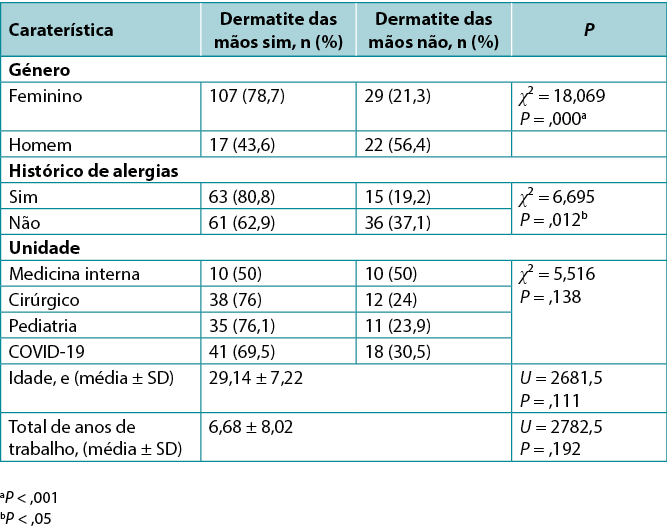
Os sintomas mais frequentemente relatados foram vermelhidão e fissuras (rasgões lineares bem definidos na epiderme e derme;77,1%), irritação e prurido (76%) e escamação/erupção cutânea (67,4%; Figura 1).
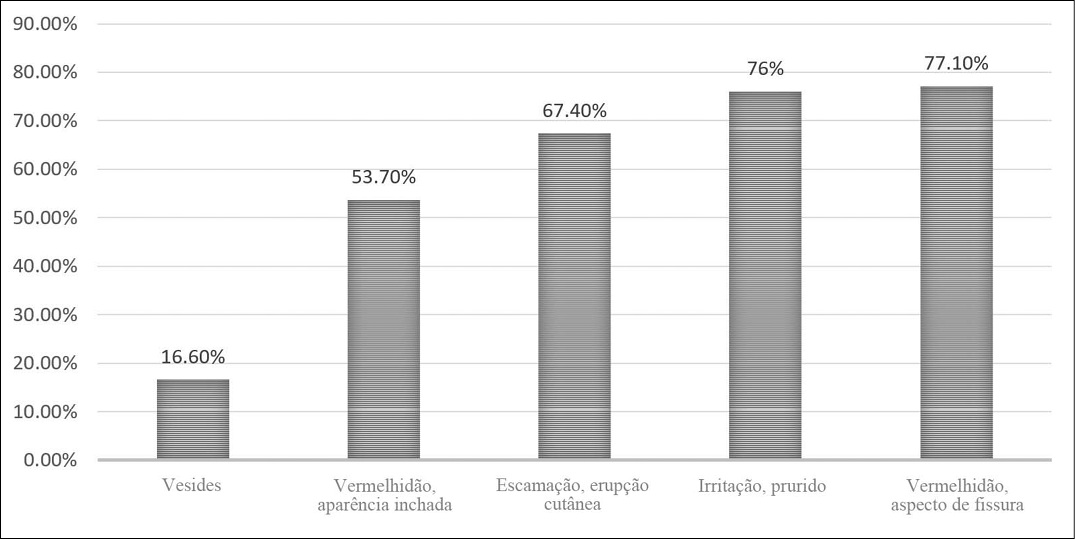
Figura 1. sintomas de dermatite das mãos
A frequência da dermatite das mãos foi de 71,5% entre os enfermeiros que prestaram cuidados a doentes positivos à COVID-19, enquanto que a frequência da dermatite das mãos foi de 66.7% entre os enfermeiros que não prestaram cuidados a doentes positivos à COVID-19. Esta diferença não foi significativa (Quadro 2).
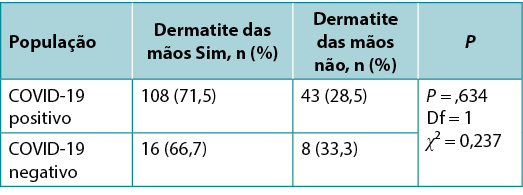
Quadro 2. Frequência da dermatite das mãos com base no facto de os enfermeiros cuidarem de pacientes positivos para a COVID-19
Foram examinados os comportamentos de higiene das mãos dos enfermeiros antes e durante a pandemia da COVID-19 (Quadro 3). Foi determinado que a frequência de lavagem das mãos por dia, o uso de desinfectantes e o uso de creme/hidratante para as mãos tinha aumentado significativamente durante a pandemia (P < ,001). Em termos de frequência de lavagem das mãos, 48% (84 de 175) dos enfermeiros lavavam as mãos mais de 25 vezes por dia. A frequência da dermatite das mãos aumentou significativamente com o aumento da frequência da lavagem das mãos (Quadro 4; P < ,05). A frequência do uso de desinfectante e creme para as mãos não afectou significativamente a dermatite das mãos (P > ,05). As substâncias mais frequentemente utilizadas na lavagem das mãos foram o sabão líquido, o sabão líquido misturado com gel à base de álcool, o gel à base de clorexidina e o gel à base de álcool (Figura 2).
Quadro 3. Comportamentos de higiene das mãos dos enfermeiros, antes e durante a pandemia
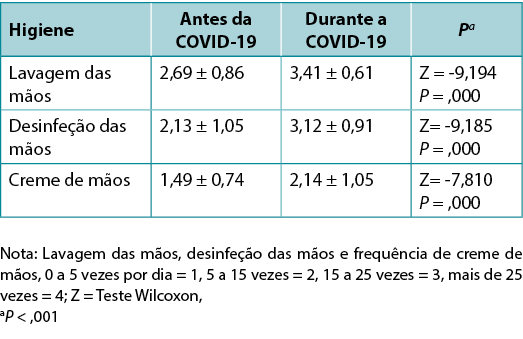
Quadro 4. Frequência de dermatites das mãos por comportamento higiénico
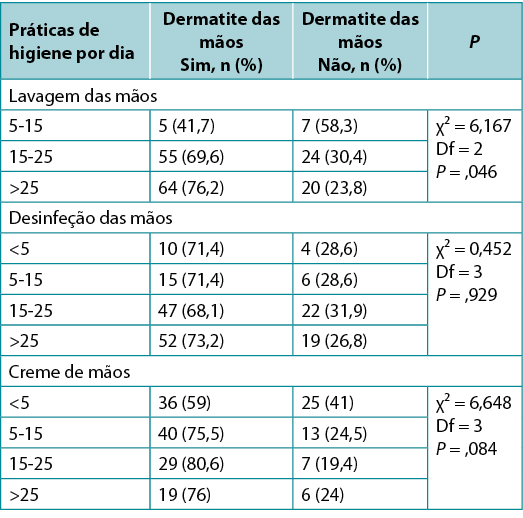
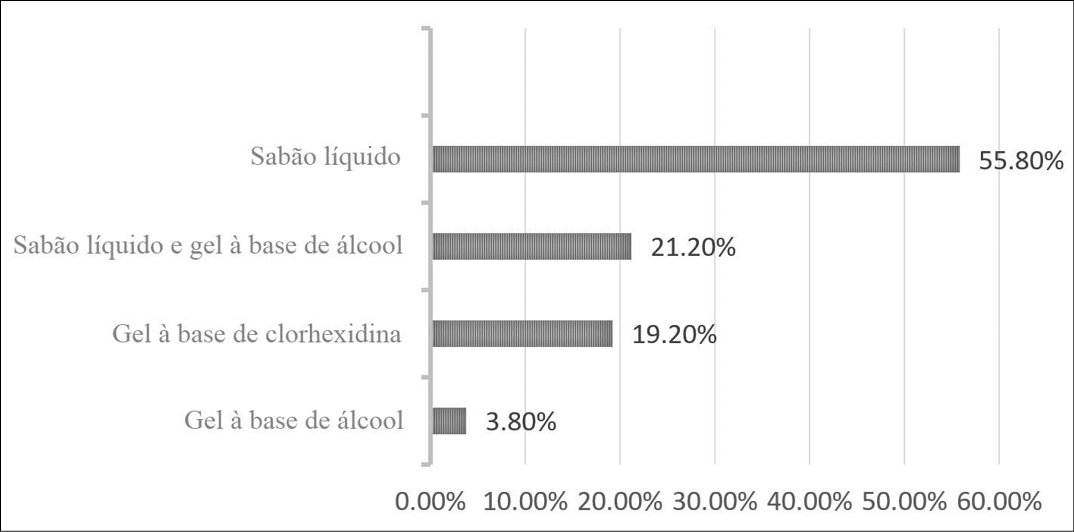
Figura 2. substâncias utilizadas pelos enfermeiros para a lavagem das mãos
Discussão
A dermatite das mãos é uma doença comum que pode progredir de forma aguda ou crónica e que tem diferentes etiologias.15 No estudo atual, a frequência da dermatite das mãos entre enfermeiros durante a pandemia da COVID-19 foi de 70.9%. Os resultados do presente estudo foram semelhantes aos obtidos em outros estudos realizados sobre dermatite das mãos em trabalhadores da saúde durante a pandemia da COVID-19. Um estudo realizado durante a pandemia revelou que 84.6% dos profissionais de saúde tinham reações cutâneas indesejadas nas mãos.16 Outro estudo relatou que 74.5% dos profissionais de saúde primários tinham lesões cutâneas nas mãos.10 Um estudo realizado no início da pandemia revelou que 90.4% dos profissionais de saúde tinham sintomas agudos de dermatite das mãos.17
Num estudo realizado na mesma região do atual estudo antes da pandemia, 47.5% dos enfermeiros que trabalhavam em clínicas pediátricas foram reportados como tendo dermatite das mãos.11 A frequência da dermatite das mãos foi de 12%,18 21%,19,20 e 22,1%21 em outros estudos realizados antes da pandemia. Dado estes resultados, é evidente que a frequência da dermatite das mãos tinha aumentado entre os trabalhadores da saúde durante a pandemia.
Neste estudo, a frequência da dermatite das mãos foi significativamente mais elevada nas mulheres do que nos homens. Alluhayyan et al22 realizaram um estudo com profissionais de saúde e descobriram que as mulheres eram mais propensas à dermatite. Da mesma forma, Gupta et al23 descobriram que a dermatite das mãos era ligeiramente mais comum nas mulheres do que nos homens. No entanto, outros estudos relataram que o género não teve um efeito significativo na frequência da dermatite das mãos.12,21
As alergias são reacções anormais de hipersensibilidade do sistema imunitário contra substâncias estranhas.24,25 Esta resposta pode ser observada tanto na primeira infância como na adolescência e ainda na idade adulta.25,26 A frequência da dermatite das mãos era significativamente mais elevada entre os enfermeiros que tinham um historial de alergia, em comparação com os que não tinham alergia, o que é consistente com estudos anteriores.12,19,21,23 Contudo, Kiely et al27 concluíram que uma história de alergia não afetou o desenvolvimento da dermatite, apesar de relatarem que o risco de desenvolver dermatite era significativamente maior nos trabalhadores da saúde com um historial de dermatite.
Um dos métodos mais comuns para prevenir a propagação de vírus é a higiene eficaz das mãos. Na luta contra a COVID-19 é essencial que hábitos eficazes de higiene das mãos sejam adquiridos na infância.28 Kiely et al27 relataram que durante a pandemia, a frequência de lavagem das mãos aumentou entre quase todos os trabalhadores de saúde (99.26%). Quando os períodos pré-pandémicos e pandémicos foram comparados no estudo atual, verificou-se que a frequência da lavagem das mãos e a utilização de desinfectantes para as mãos/cremes tinha aumentado significativamente (Quadro 3). Da mesma forma, Guertler et al17 realizaram um estudo com médicos e enfermeiros, encontrando resultados semelhantes. Todas as directrizes para combater a COVID-19 recomendam práticas de higiene das mãos completas e frequentes.2,5 Embora o aumento da frequência da lavagem das mãos seja um dos fatores que contribui para o desenvolvimento da dermatite, isto não deve dissuadir os profissionais de saúde de práticas adequadas de higiene das mãos durante a pandemia.4
Os enfermeiros são os principais prestadores de cuidados num ambiente médico e são, por esse motivo, propensos à infeção e transmissão do vírus COVID-19. É vital, para combater a pandemia, que cumpram as directrizes de prevenção e controlo das infeções.29
Num outro estudo realizado durante a pandemia, Lan et al10 concluíram que a frequência da dermatite das mãos aumentou significativamente nos profissionais de saúde que lavavam as mãos mais de 10 vezes por dia. Estudos realizados antes da pandemia relataram uma relação significativa entre o aumento da frequência da lavagem das mãos e a frequência da dermatite das mãos.12,30 Contudo, o presente estudo não encontrou uma diferença significativa na frequência da dermatite das mãos resultante da utilização de creme de mãos. No entanto, os cremes para as mãos utilizados pelos enfermeiros podem não ser os ideais. Recomenda-se a utilização de hidratantes de pele para manter a pele saudável;31,32 para a proteção da pele, são recomendados hidratantes como ureia tópica e propilenoglicol e também emolientes oclusivos tais como produtos à base de petrolato, lanolina, óleos minerais e vegetais e ceras em conjunto. O uso concomitante é benéfico para manter o estrato córneo húmido e suavizar a pele.33
Conclusões
Este estudo descobriu que era elevada a frequência da dermatite das mãos entre os enfermeiros durante a pandemia. Género, historial de alergias e o aumento da frequência da lavagem das mãos estavam entre os fatores que aumentavam a dermatite das mãos. Durante a pandemia, a higiene das mãos aumentou significativamente entre os trabalhadores da saúde. Verificou-se também que os enfermeiros aumentaram as medidas que tomaram para proteger a sua pele de forma a evitar dermatites.
A desinfeção das mãos desempenha um papel estratégico importante na luta contra a COVID-19. No entanto, a barreira da pele e da mucosa é susceptível de ser danificada em enfermeiros que praticam consistentemente uma boa higiene. Durante o desempenho das suas funções, os enfermeiros devem tomar as medidas adequadas para proteger a sua pele.
Author(s)
Ayla İrem Aydın*
MSc, RN
Research Assistant, Department of Pediatric Nursing, Faculty of Health Sciences, Bursa Uludağ University, Turkey
Meryem Atak
MSc, RN
Research Assistant, Department of Pediatric Nursing, Faculty of Health Sciences, Bursa Uludağ University, Turkey
Nurcan Özyazıcıoğlu Nurcan
PhD, RN
Professor, Dean of Faculty of Health Sciences
Department of Pediatric Nursing, Faculty of Health Sciences, Bursa Uludağ University, Turkey
Vahit Dalkızan
RN
Nurse in the ICU, Ministry of Health Bursa City Hospital, Turkey
* Corresponding author
References
- World Health Organization. Coronavirus disease (COVID-19) pandemic. 2021. www.who.int/emergencies/diseases/novel-coronavirus-2019. Last accessed September 27, 2021.
- Centers for Disease Control & Prevention. Coronavirus Disease 2019 (COVID-19). June 2021. www.cdc.gov/coronavirus/2019-ncov/prevent-getting-sick/hand-sanitizer.html. Last accessed June 25, 2021.
- Aiello AE, Perez V, Coulborn RM, Davis BM, Uddin M, Monto AS. Facemasks, hand hygiene, and influenza among young adults: a randomized intervention trial. PloS One 2012;7:e29744.
- Sibbald RG, Ayello EA. Hand dermatitis, hand hygiene, and healthcare professionals. Adv Skin Wound Care 2020;33:175.
- World Health Organization. WHO save lives: Clean your hands. May 2020. www.who.int/docs/default-source/infection-prevention-and-control/clean-hands-2020/advocacy-slides-2020-long-version.pdf. Last accessed October 1, 2021.
- Townsend J, Greenland K, Curtis V. Costs of diarrhoea and acute respiratory infection attributable to not handwashing: the cases of India and China. Trop Med Int Health 2017;22:74-81.
- World Health Organization. Coronavirus disease (COVID-19) advice for the public. June 2021. www.who.int/emergencies/diseases/novel-coronavirus-2019/advice-for-public. Last accessed June 25, 2021.
- Maliyar K, Sibbald C, Pope E, Gary Sibbald R. Diagnosis and management of atopic dermatitis: a review. Adv Skin Wound Care 2018;31:538–50.
- Al Badri FM. Surgical mask contact dermatitis and epidemiology of contact dermatitis in healthcare workers. Curr Allergy Clin Immunol 2017;30:183-8.
- Lan J, Song Z, Miao X, et al. Skin damage among health care workers managing coronavirus disease-2019. J Am Acad Dermatol 2020;82:1215-6.
- Özyazıcıoğlu N, Sürenler S, Tanrıverdi G. Hand dermatitis among paediatric nurses. J Clin Nurs 2010;19:1597-603.
- Özyazicioglu N, Sürenler S, Aydin AI, Atak M. Hand dermatitis in nursing students. Adv Skin Wound Care 2020;33:213-6.
- Smit HA, Coenraads PJ, Lavrijsen PM, Nater JP. Evaluation of a self-administered questionnaire on hand dermatitis. Contact Dermatitis 1992;26:11–6.
- Smit HA, Burdorf A, Coenraads PJ. Prevalence of hand dermatitis in different occupations. Int J Epidemiol 1993;22:288–93.
- Alavi A, Skotnicki S, Sussman G, Sibbald RG. Diagnosis and treatment of hand dermatitis. Adv Skin Wound Care 2012;25:371-80.
- Lin P, Zhu S, Huang Y, et al. Adverse skin reactions among healthcare workers during the coronavirus disease 2019 outbreak: a survey in Wuhan and its surrounding regions. Br J Dermatol 2020;183:190-2.
- Guertler A, Moellhoff N, Schenck TL, et al. Onset of occupational hand eczema among healthcare workers during the SARS-CoV-2 pandemic: Comparing a single surgical site with a COVID-19 intensive care unit. Contact Dermatitis 2020;83:108-14.
- van der Meer EW, Boot CR, van der Gulden JW, Jungbauer FH, Coenraads PJ, Anema JR. Hand eczema among healthcare professionals in the Netherlands: prevalence, absenteeism, and presenteeism. Contact Dermatitis 2013;69:164-71.
- Ibler KS, Jemec GB, Flyvholm MA, Diepgen TL, Jensen A, Agner T. Hand eczema: prevalence and risk factors of hand eczema in a population of 2274 healthcare workers. Contact Dermatitis 2012;67:200-7.
- Hamnerius N, Svedman C, Bergendorff O, Björk J, Bruze M, Pontén A. Wet work exposure and hand eczema among healthcare workers: a cross-sectional study. Br J Dermatol 2018;178:452-61.
- Luk NM, Lee HC, Luk CK, et al. Hand eczema among Hong Kong nurses: a self-report questionnaire survey conducted in a regional hospital. Contact Dermatitis 2011;65:329-35.
- Alluhayyan OB, Alshahri BK, Farhat AM, et al. Occupational-related contact dermatitis: prevalence and risk factors among healthcare workers in the Al’Qassim Region, Saudi Arabia during the COVID-19 pandemic. Cureus 2020;12:e10975.
- Gupta SB, Gupta A, Shah B, et al. Hand eczema in nurses, nursing auxiliaries and cleaners- a cross-sectional study from a tertiary hospital in western India. Contact Dermatitis 2018;79:20-5.
- American Academy of Allergy, Asthma & Immunology. Allergies. 2021. www.aaaai.org/conditions-and-treatments/allergies. Last accessed June 25, 2021.
- Hopp RJ. Hypersensitivity reactions: an everyday occurrence in pediatric allergy clinics. Pediatr Allergy Immunol Pulmonol 2020;33:12-8.
- Czarnowicki T, He H, Krueger JG, Guttman-Yassky E. Atopic dermatitis endotypes and implications for targeted therapeutics. J Allergy Clin Immunol 2019;143:1–11.
- Kiely LF, Moloney E, O’Sullivan G, Eustace JA, Gallagher J, Bourke JF. Irritant contact dermatitis in healthcare workers as a result of the COVID-19 pandemic: a cross-sectional study. Clin Exp Dermatol 2021;46(1):142-4.
- Borch L, Thorsteinsson K, Warner TC, et al. COVID-19 reopening causes high risk of irritant contact dermatitis in children. Dan Med J 2020;67:A05200357.
- Lotfinejad N, Peters A, Pittet D. Hand hygiene and the novel coronavirus pandemic: the role of healthcare workers. J Hosp Infect 2020;105:776-7.
- Zhang D, Zhang J, Sun S, Gao M, Tong A. Prevalence and risk factors of hand eczema in hospital-based nurses in northern China. Australas J Dermatol 2018;59:e194-7.
- Yan Y, Chen H, Chen L, et al. Consensus of Chinese experts on protection of skin and mucous membrane barrier for health-care workers fighting against coronavirus disease 2019. Dermatol Ther 2020;33:e13310.
- Gupta MK, Lipner SR. Hand hygiene in preventing COVID-19 transmission. Cutis 2020;105:233-4.
- Beiu C, Mihai M, Popa L, Cima L, Popescu MN. Frequent hand washing for COVID-19 prevention can cause hand dermatitis: management tips. Cureus 2020;12:e7506.


